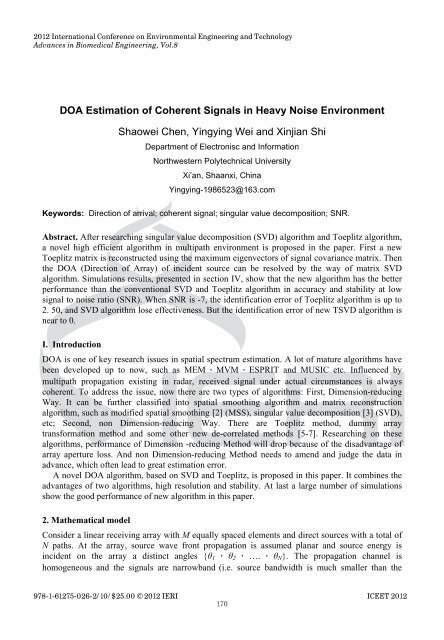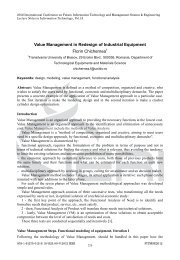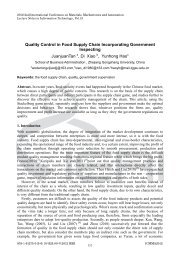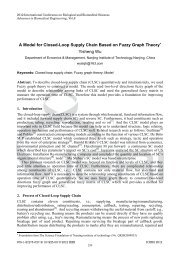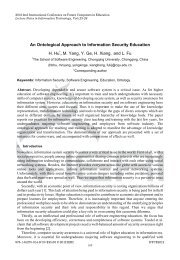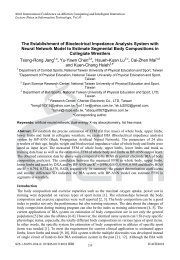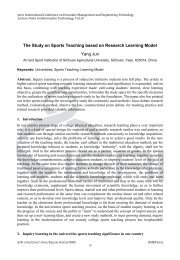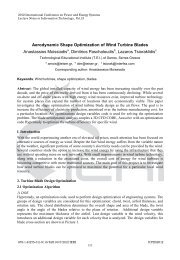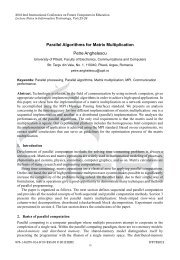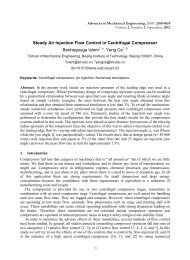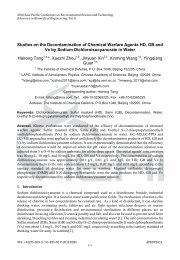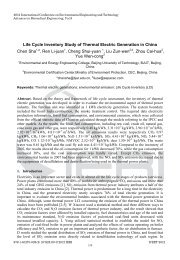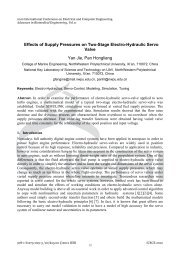DOA Estimation of Coherent Signals in Heavy Noise ... - IERI
DOA Estimation of Coherent Signals in Heavy Noise ... - IERI
DOA Estimation of Coherent Signals in Heavy Noise ... - IERI
You also want an ePaper? Increase the reach of your titles
YUMPU automatically turns print PDFs into web optimized ePapers that Google loves.
2012 International Conference on Environmental Eng<strong>in</strong>eer<strong>in</strong>g and Technology<br />
Advances <strong>in</strong> Biomedical Eng<strong>in</strong>eer<strong>in</strong>g, Vol.8<br />
<strong>DOA</strong> <strong>Estimation</strong> <strong>of</strong> <strong>Coherent</strong> <strong>Signals</strong> <strong>in</strong> <strong>Heavy</strong> <strong>Noise</strong> Environment<br />
Shaowei Chen, Y<strong>in</strong>gy<strong>in</strong>g Wei and X<strong>in</strong>jian Shi<br />
Department <strong>of</strong> Electronisc and Information<br />
Northwestern Polytechnical University<br />
Xi’an, Shaanxi, Ch<strong>in</strong>a<br />
Y<strong>in</strong>gy<strong>in</strong>g-1986523@163.com<br />
Keywords: Direction <strong>of</strong> arrival; coherent signal; s<strong>in</strong>gular value decomposition; SNR.<br />
Abstract. After research<strong>in</strong>g s<strong>in</strong>gular value decomposition (SVD) algorithm and Toeplitz algorithm,<br />
a novel high efficient algorithm <strong>in</strong> multipath environment is proposed <strong>in</strong> the paper. First a new<br />
Toeplitz matrix is reconstructed us<strong>in</strong>g the maximum eigenvectors <strong>of</strong> signal covariance matrix. Then<br />
the <strong>DOA</strong> (Direction <strong>of</strong> Array) <strong>of</strong> <strong>in</strong>cident source can be resolved by the way <strong>of</strong> matrix SVD<br />
algorithm. Simulations results, presented <strong>in</strong> section IV, show that the new algorithm has the better<br />
performance than the conventional SVD and Toeplitz algorithm <strong>in</strong> accuracy and stability at low<br />
signal to noise ratio (SNR). When SNR is -7, the identification error <strong>of</strong> Toeplitz algorithm is up to<br />
2. 50, and SVD algorithm lose effectiveness. But the identification error <strong>of</strong> new TSVD algorithm is<br />
near to 0.<br />
I. Introduction<br />
<strong>DOA</strong> is one <strong>of</strong> key research issues <strong>in</strong> spatial spectrum estimation. A lot <strong>of</strong> mature algorithms have<br />
been developed up to now, such as MEM、MVM、ESPRIT and MUSIC etc. Influenced by<br />
multipath propagation exist<strong>in</strong>g <strong>in</strong> radar, received signal under actual circumstances is always<br />
coherent. To address the issue, now there are two types <strong>of</strong> algorithms: First, Dimension-reduc<strong>in</strong>g<br />
Way. It can be further classified <strong>in</strong>to spatial smooth<strong>in</strong>g algorithm and matrix reconstruction<br />
algorithm, such as modified spatial smooth<strong>in</strong>g [2] (MSS), s<strong>in</strong>gular value decomposition [3] (SVD),<br />
etc; Second, non Dimension-reduc<strong>in</strong>g Way. There are Toeplitz method, dummy array<br />
transformation method and some other new de-correlated methods [5-7]. Research<strong>in</strong>g on these<br />
algorithms, performance <strong>of</strong> Dimension -reduc<strong>in</strong>g Method will drop because <strong>of</strong> the disadvantage <strong>of</strong><br />
array aperture loss. And non Dimension-reduc<strong>in</strong>g Method needs to amend and judge the data <strong>in</strong><br />
advance, which <strong>of</strong>ten lead to great estimation error.<br />
A novel <strong>DOA</strong> algorithm, based on SVD and Toeplitz, is proposed <strong>in</strong> this paper. It comb<strong>in</strong>es the<br />
advantages <strong>of</strong> two algorithms, high resolution and stability. At last a large number <strong>of</strong> simulations<br />
show the good performance <strong>of</strong> new algorithm <strong>in</strong> this paper.<br />
2. Mathematical model<br />
Consider a l<strong>in</strong>ear receiv<strong>in</strong>g array with M equally spaced elements and direct sources with a total <strong>of</strong><br />
N paths. At the array, source wave front propagation is assumed planar and source energy is<br />
<strong>in</strong>cident on the array a dist<strong>in</strong>ct angles {θ 1 , θ 2 , …. , θ N }. The propagation channel is<br />
homogeneous and the signals are narrowband (i.e. source bandwidth is much smaller than the<br />
978-1-61275-026-2/10/$25.00 ©2012 <strong>IERI</strong> ICEET 2012<br />
170
eciprocal <strong>of</strong> propagation time <strong>of</strong> the signal across the array). Then the received signal at the kth<br />
time is given by<br />
X( k) = AS( k) + N ( k), k = 1,2,..., K<br />
(1)<br />
Where,<br />
X ( k) = [ x1<br />
( k) … x ( )]<br />
T<br />
M<br />
k<br />
T<br />
jw0<br />
k<br />
Sk ( ) = [ s1<br />
( k) … sN( k) ] , si( k) = ai( ke )<br />
A= [ a( θ ) a( θ ) … a( θ )]<br />
1 2<br />
a θ β π θ λ<br />
− jβ<br />
− j( M −1)<br />
i<br />
(<br />
i) = [1 e e β ],<br />
i<br />
= 2 ds<strong>in</strong> i<br />
/<br />
Nk ( ) = [ n1<br />
( k) n ( )]<br />
T<br />
M<br />
k<br />
Where, d is the sensor spac<strong>in</strong>g, λ is the process<strong>in</strong>g center wave length, ω 0 is the process<strong>in</strong>g center<br />
angular frequency<br />
Therefore, the spatial covariance matrix is:<br />
2<br />
R = [ XX H ] = A [ SS H ] A H + I<br />
H<br />
H<br />
= USΣSUS + UNΣ NU<br />
N<br />
E E σ<br />
Where, ‘H’ denotes the complex conjugate transpose; ‘E’ stands for expectation, an ensemble<br />
average operator; I is M×M identity matrix; U S =[e 1 e 2 … e N ] is signal subspace, consist<strong>in</strong>g by<br />
eigenvectors correspond<strong>in</strong>g to largest N eigenvalue; U N =[e N+1 e N+2 … e M ] is noise subspace,<br />
consist<strong>in</strong>g by eigenvectors correspond<strong>in</strong>g to smallest (M-N) eigenvalues; Σ S is diagonal matrix<br />
consist<strong>in</strong>g <strong>of</strong> large eigenvalue; Σ N is diagonal matrix consist<strong>in</strong>g <strong>of</strong> smallest N eigenvalues; σ 2<br />
denote ideal white noise power.<br />
In direction f<strong>in</strong>d<strong>in</strong>g problems, eigenstructure methods <strong>of</strong> estimat<strong>in</strong>g the directions <strong>of</strong> arrival {θ i }<br />
are based on exploit<strong>in</strong>g this structure <strong>of</strong> R. That is, R has a range basis consist<strong>in</strong>g <strong>of</strong> the direction<br />
vectors <strong>of</strong> source plane waves, and R is the sum <strong>of</strong> an N-rank matrix U S Σ S U H S and σ 2 I.<br />
The noise subspace vectors are orthogonal to all the steer<strong>in</strong>g vectors. The MUSIC spectrum is a<br />
cont<strong>in</strong>uous spectrum formed as<br />
1<br />
PMUSIC<br />
( θ ) =<br />
(3)<br />
H<br />
2<br />
a ( θ ) U<br />
The source directions can be estimated as the peaks <strong>of</strong> the spatial spectrum.<br />
Conventional eigen-structure methods, however, are applicable only when the path signal<br />
covariance matrix is non-s<strong>in</strong>gular. When some <strong>of</strong> the path signals are coherent (for examples, if<br />
they orig<strong>in</strong>ate from the same source), the path signal covariance matrix will be s<strong>in</strong>gular and<br />
properties noted do not hold. Up to now, to solve this problem there are many methods for coherent<br />
signal. SVD and Toeplitz algorithm are two k<strong>in</strong>ds <strong>of</strong> typical methods.<br />
2.1 SVD method<br />
SVD (s<strong>in</strong>gular value decomposition) algorithm has been proposed as Reference [3]. The<br />
[3]<br />
largest eigenvector e 1 is formed as<br />
T<br />
e1 = [ e11, e12, e13...... e1M<br />
]<br />
k=<br />
N<br />
(4)<br />
T<br />
= α a( θ ) = [ x(1) x(2)... x( M)]<br />
∑<br />
k = 1<br />
1<br />
k<br />
Therefore, the largest eigenvector e 1 conta<strong>in</strong>s all the source direction <strong>in</strong>formation. Then a new<br />
matrix Y can be formed by utiliz<strong>in</strong>g e 1 .<br />
⎡ e1,1 e1,2 e1,<br />
p ⎤<br />
⎢<br />
⎥<br />
⎢<br />
e1,2 e1,3 e1, s+<br />
1<br />
Y = ⎥<br />
(5)<br />
⎢ ⎥<br />
⎢<br />
⎥<br />
⎢⎣<br />
e1, m<br />
e1, r+<br />
1<br />
e1,<br />
M ⎥⎦<br />
N<br />
N<br />
(2)<br />
171
Where, m+p-1=M. The noise subspace can be obta<strong>in</strong>ed by s<strong>in</strong>gular value decomposition <strong>of</strong> the<br />
matrix Y. F<strong>in</strong>ally, <strong>DOA</strong> can be estimated accord<strong>in</strong>g to formula 3.<br />
2.2 Toeplitz approximation method<br />
S. Y. Kung et al.[4] proposed a Toeplitz Approximation Method (TAM) which is based on a<br />
reduced order Toeplitz approximation <strong>of</strong> an estimated spatial covariance matrix. The estimated<br />
covariance matrix, <strong>in</strong> the case <strong>in</strong> which sources are uncorrelated and statistically stationary, is<br />
Toeplitz. In a multipath environment, however, the source paths are fully correlated, and this<br />
covariance matrix is not Toeplitz. The Toeplitz structure can he guaranteed by employ<strong>in</strong>g spatial<br />
smooth<strong>in</strong>g, which destroys cross correlation between directional components. The TAM is designed<br />
for robustness <strong>in</strong> an arbitrary ambient noise environment.<br />
3. Tsvd algorithm<br />
In accordance with the forego<strong>in</strong>g analysis, a novel direction f<strong>in</strong>d<strong>in</strong>g algorithm, based on the<br />
advantages <strong>of</strong> SVD and TAM, is proposed <strong>in</strong> this paper. First, eigenvalue decomposition <strong>of</strong> the<br />
spatial covariance matrix is [U, S]= eig (R), where, U denotes eigenvectors matrix; S represents<br />
egenvaluses matrix. As previous analysis, the largest eigenvector e 1 associated with the matrix U<br />
completely <strong>in</strong>clude <strong>in</strong>formation <strong>of</strong> received source paths. Consider<strong>in</strong>g correlated source paths,<br />
decoherent e 1<br />
'<br />
rm<br />
= e11 × e1<br />
m<br />
(6)<br />
Obviously, the angles element still exists <strong>in</strong> the vector r m .<br />
As we all known like given <strong>in</strong> the TAM algorithm, the Toeplitz matrix can destroy cross<br />
correlation between directional components. Now, we form the new covariance matrix as follow:<br />
⎡ r1 r2<br />
rM<br />
⎤<br />
⎢ '<br />
r2 r1 r ⎥<br />
M −1<br />
Y = ⎢<br />
⎥<br />
⎢ ⎥<br />
(7)<br />
⎢ ' '<br />
⎥<br />
⎣rM<br />
rM−<br />
1<br />
r1<br />
⎦<br />
We can easily verify the new matrix Y is Toeplitz structure (conjugate symmetric matrix).<br />
Then, perform an SVD on Y, [U, S, V]=svd(Y) and arrange the s<strong>in</strong>gular values <strong>in</strong> decreas<strong>in</strong>g.<br />
The SVD is<br />
⎡S1 0 ⎤⎡V′<br />
1⎤<br />
Y = USV′<br />
= [ U1 U2]<br />
⎢<br />
0 S<br />
⎥⎢<br />
2<br />
V<br />
⎥<br />
(8)<br />
⎣ ⎦⎣ 2 ′ ⎦<br />
Where, S should ideally be a diagonal matrix <strong>of</strong> N eigenvalues; the N×N diagonal matrix S 1<br />
conta<strong>in</strong>s the N largest s<strong>in</strong>gular values; the (M-N)×(M-N) diagonal matrix S 2 conta<strong>in</strong>s the (M-N)<br />
smallest s<strong>in</strong>gular values. U stands for left s<strong>in</strong>gular matrix; V stands for right s<strong>in</strong>gular matrix.<br />
Similarly, the N columns eigenvectors correspond<strong>in</strong>g to S 1 <strong>of</strong> matrix U is signal subspace. The (M-<br />
N) columns eigenvectors correspond<strong>in</strong>g to S 1 <strong>of</strong> matrix U is noise subspace Un=U (:, (N+1):M).<br />
With the equation 3, the source directions can be estimated quickly.<br />
In summary, the five steps <strong>of</strong> the novel approach are:<br />
Step1<br />
Calculate the spatial covariance matrix R;<br />
Step2<br />
Perform eigenvalue decomposition on R. Extract the largest vector e 1 accord<strong>in</strong>g to the largest<br />
eigenvalue;<br />
Step3<br />
Reconstruct the new Toeplitz covariance matrix Y accord<strong>in</strong>g to equation 7;<br />
Step4<br />
172
Perform an SVD on Y, so we can easily obta<strong>in</strong> noise subspace Un;<br />
Stpe5<br />
Search the peak <strong>of</strong> the cont<strong>in</strong>uous spectrum as the <strong>DOA</strong> <strong>of</strong> source accord<strong>in</strong>g to formula 3.<br />
4. Simulations<br />
The snapshot model consists <strong>of</strong> a l<strong>in</strong>ear array <strong>of</strong> 8 equispaced with <strong>in</strong>ter-element spac<strong>in</strong>g <strong>of</strong> one half<br />
wavelengths. Two equal-powered emitters at angular locations 15° and 22°. The number <strong>of</strong><br />
snapshots sets to 100. In order to perform SVD 、Toeplitz and TSVD applied to the direction<br />
f<strong>in</strong>d<strong>in</strong>g, the temporal snapshot data and Gaussian noise data were generated artificially by a<br />
computer. The simulation results is given as Fig.1-4.<br />
Fig. 1 shows simulation results for SVD、Toeplitz and TSVD at SNR <strong>of</strong> 7dB. Three methods<br />
all can resolve the emitters, but TSVD yields nearer optimal angle estimates than other two<br />
algorithms. But SNR decrease to -7dB, Fig. 2 shows that TSVD has the accurate performance. The<br />
SVD cannot resolve the angles, while the error <strong>of</strong> the Toeplitz is up to 2.5°.<br />
150<br />
Spatial spectrum (dB)<br />
100<br />
50<br />
0<br />
TSVD<br />
SVD<br />
Toeplitz<br />
-50<br />
0 10 20 30 40<br />
Angle (°)<br />
Figure.1 The three arrows <strong>in</strong>dicate the orig<strong>in</strong>al spectral peaks at 7dB SNR.<br />
100<br />
Spatial spectrum (dB)<br />
80<br />
60<br />
40<br />
20<br />
0<br />
-20<br />
TSVD<br />
SVD<br />
Toeplitz<br />
0 10 20 30 40<br />
Angle (°)<br />
Figure.2 The three arrows <strong>in</strong>dicate the orig<strong>in</strong>al spectral peaks at -7dB SNR.<br />
In the same environment condition we carry 100 Monte Carlo trials. Fig. 3-4 respectively show<br />
Monte Carlo simulation results <strong>of</strong> the error and success probability for SVD、Toeplitz and TSVD.<br />
Obviously, the success probability <strong>of</strong> TSVD is near to 100% at a SNR <strong>of</strong> -10dB, <strong>in</strong> contrary SVD is<br />
down to 0. Although Toeplitz can achieve high success probability, the error is greater than new<br />
method. So we can summarize TSVD has optimal resolution and stability compar<strong>in</strong>g to<br />
conventional SVD and Toeplitz algorithms particularly at low SNR.<br />
173
<strong>Estimation</strong> error (°)<br />
1.4<br />
1.2<br />
1<br />
0.8<br />
0.6<br />
0.4<br />
0.2<br />
TSVD<br />
SVD<br />
Toeplitz<br />
0<br />
0 5 10 15 20<br />
SNR (dB)<br />
Figure.3 <strong>Estimation</strong> error for three algorithms at SNR <strong>of</strong> 0-20.1<br />
1<br />
0.8<br />
TSVD<br />
SVD<br />
Toeplitz<br />
Success probability<br />
0.6<br />
0.4<br />
0.2<br />
0<br />
-10 -5 0 5 10 15 20<br />
SNR (dB)<br />
Figure.4 Success probability for SVD、Toeplitz and TSVD at SNR <strong>of</strong> -10 to 20.<br />
5. Conclusion<br />
TSVD algorithm for <strong>DOA</strong> f<strong>in</strong>d<strong>in</strong>g problems, with application <strong>in</strong> multipath environment with l<strong>in</strong>ear<br />
equispaced arrays, has been presented. The algorithm comb<strong>in</strong>es the advantages <strong>of</strong> two classical<br />
algorithms, has excellent performance. At last simulations results <strong>in</strong>dicate that it can be optimistic<br />
<strong>in</strong> expect<strong>in</strong>g high resolution and good accuracy when a greatly low SNR is used.<br />
References<br />
[1] H. Krim, M. Viberg. “Two Decades <strong>of</strong> Array Signal Process<strong>in</strong>g Research,” IEEE Signal<br />
Process<strong>in</strong>g Magaz<strong>in</strong>e, vol. 7, pp. 67-94, 1996..<br />
[2] R. T. Williams, S. Prasad, A. K. Mahalanabis and L. H. sibul. “An Improved Spatial Smooth<strong>in</strong>g<br />
Technique for Bear<strong>in</strong>g <strong>Estimation</strong> <strong>in</strong> a Multipath Environment,” IEEE Trans on ASSP, vol.<br />
36,no. 4, pp. 425-432, 1998.<br />
[3] D. W. Tufts, A. C. Kot and R. J. Vacco. “The Threshold Analysis <strong>of</strong> SVD-based Algorithms,”<br />
IEEE <strong>in</strong>ternational conference ICASSP-88, pp. 2416-2419. 1988.<br />
[4] Kung S Y, Lo C K, Foka R. “A toeplitz approximation approach to coherent source direction<br />
f<strong>in</strong>d<strong>in</strong>g,” IEEE <strong>in</strong>ternational conference ICASSP-86, vol. 11, pp. 193-196, 1986.<br />
[5] Kaneko, Kazumasa Sano, Akira. “Music-like Iterative <strong>DOA</strong> <strong>Estimation</strong> <strong>in</strong> Multipath<br />
Environments,” IEEE Sensor Array and Multichannel Signal Process<strong>in</strong>g Workshop. pp. 212-<br />
215, 2008.<br />
174
[6] T<strong>in</strong>g D<strong>in</strong>g. “Modified <strong>DOA</strong> <strong>Estimation</strong> Algorithm For Reduc<strong>in</strong>g Correlation <strong>of</strong> Multi-path<br />
<strong>Signals</strong>,” Information Security and Communications Privacy, vol. 2, pp. 53-55, February. 2008.<br />
[7] X<strong>in</strong> Xie, Guol<strong>in</strong> Li and Huawen Liu. “<strong>DOA</strong> <strong>Estimation</strong> <strong>of</strong> <strong>Coherent</strong> <strong>Signals</strong> Us<strong>in</strong>g one<br />
Snapshot,” Journal <strong>of</strong> Electronics and Information Technology. Vol. 32, no. 3, pp. 604-608,<br />
March 2010.<br />
175


